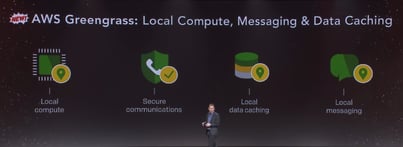By Megan Bozman
Amazon Web Services (AWS) re:Invent, the largest gathering of the global AWS community, spans six days and is currently underway in Las Vegas. During a Keynote Wednesday, Andy Jassy, CEO, Amazon Web Services, announced several new offerings, including AWS Greengrass, designed to tackle some of the primary challenges facing the IoT today.
IoT and the Cloud
The number of servers companies manage is going to shrink, but the number of IoT devices is going to proliferate at a fast rate as people are anxious to have data collection devices on all their assets.
IoT devices tend to be relatively limited in their capabilities. “They have a very small amount of CPU and a very small amount of disc, and it’s why the cloud is disproportionately important to these IoT devices. And it’s also why you see so many IoT use cases being built on top of AWS,” explained Mr. Jassy.
However, there are going to be times when you don’t want to make the round trip to the cloud. For example, when latency is an issue, or nodes in locations without connectivity, or where bandwidth is expensive.
Mr. Jassy stated that AWS heard customers wanted the ability for IoT devices to have the same flexibility and programming model to do compute and analytics as they do with AWS.
AWS Greengrass
AWS Greengrass is a new service that extends the AWS programming model to small, simple, field-based devices. It is designed to address common IoT challenges such as intermittent, unreliable connectivity, and limitations on power and storage. The AWS Greengrass webpage beautifully sums up the offering as, “Local compute, messaging & data caching for connected devices.
“AWS Greengrass seamlessly extends AWS to devices so they can act locally on the data they generate, while still using the cloud for management, analytics, and durable storage.”
Benefits are outlined as:
- Respond to Local Events in Near Real-time
- Operate Offline
- Simplified Device Programming with AWS Lambda
- Reduce the Cost of Running IoT Applications
Analyzing what should be analyzed
An AWS blog explains that, “Greengrass can be programmed to filter device data and only transmit necessary information back to the cloud.” This makes perfect sense. With data storage and transmission using costly resources, it’s only sensible to prioritize what must go to the cloud.
Analyzing data collected by IoT nodes is crucial for realizing value from IoT implementations. But sometimes filtering the data that will undergo analysis is a wise first step that can increase efficiency and minimize costs. Greengrass seems to be bringing more sophisticated capabilities to IoT implementations, along with ease of use for developers.
Smart Homes Example
In many cases, smart home products communicate with a hub, which then communicates back to AWS. But manufacturers want to ensure that if connectivity is lost, products such as lighting can still function. Greengrass can serve as a secondary in case connectivity is interrupted.
“We’re really excited about what this will provide device manufacturers and developers who want to have a consistent, flexible programming model across these IoT devices and AWS,” stated Mr. Jassy.
Amazon launched a limited preview of AWS Greengrass Wednesday and interested users can sign up to participate.
The announcement of Greengrass begins at 2:00:00 in the below video.

